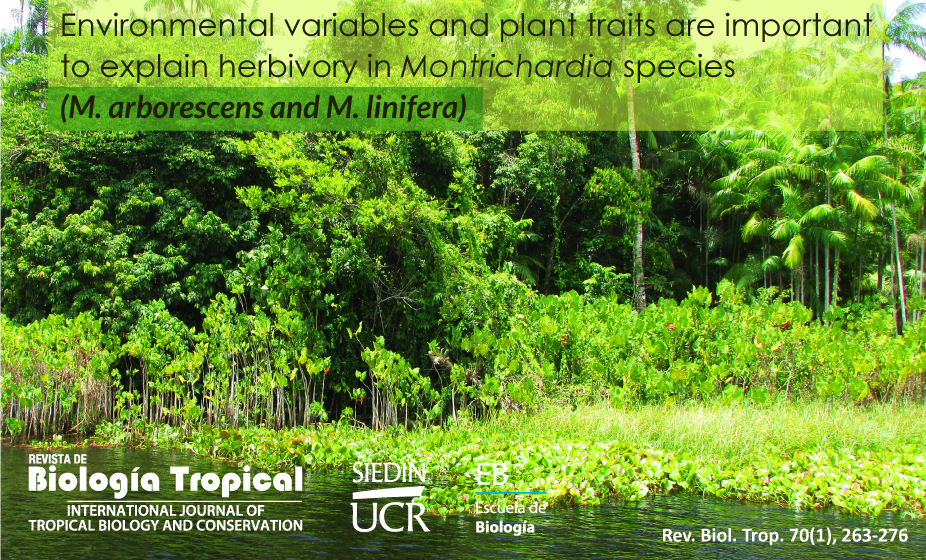Resumen
Introducción: La herbivoría es fundamental para comprender cómo las plantas invierten en diferentes estrategias para evitar la depredación, lo que implica diferentes mecanismos de defensa. Factores relacionados con el medio ambiente, la densidad de plantas y/o los rasgos funcionales de las plantas pueden influir en la herbivoría en los ecosistemas acuáticos. Sin embargo, todavía falta información sobre cómo esos factores influyen en la herbivoría en los ecosistemas acuáticos y pueden contribuir a la carga de herbivoría. Objetivo: Evaluar si existe una relación entre la herbivoría y las variables ambientales (p. ej., profundidad del agua y distancia al margen), los factores ecológicos (densidad de plantas) y los rasgos estructurales de las plantas (altura, grosor de la hoja y área foliar) e indicar estructuras anatómicas que actúen junto con los rasgos estructurales en el sistema de defensa de especies de Montrichardia. Métodos: Se evaluaron 96 individuos de Montrichardia spp. (78 de M. arborescens y 18 de M. linifera, en 18 sitios) recolectados en septiembre de 2018. En cada sitio, se midió la profundidad del agua, la distancia al margen y la densidad de plantas. De los individuos, medimos la altura de la planta, el grosor de la hoja y fotografiamos las hojas para calcular el área foliar específica y la cantidad de herbivoría (en porcentaje). Para identificar las estructuras anatómicas relacionadas con la defensa de las plantas, se recogió hojas completamente expandidas de tres individuos por cuadrante. Resultados: Para M. arborescens, las plantas con hojas más gruesas y mayor área foliar específica tienen menos daño por herbivoría. Para M. linifera, las plantas con hojas más gruesas y que habitan en sitios más profundos tienen más daño por herbívoros, mientras que las plantas más alejadas del margen tienen menos daño por herbívoros. Se encontró estructuras anatómicas relacionadas con la defensa, como células idioblásticas con compuestos fenólicos y células con inclusiones sólidas que pueden contribuir a evitar daños severos en las características de las hojas. Conclusiones: Nuestros resultados indican que la herbivoría en las especies de Montrichardia podría explicarse por una combinación de características ambientales (aislamiento del parche y profundidad del agua) y de la planta. Descubrimos que los rasgos de las hojas eran factores importantes que impulsaban los cambios en la carga de herbivoría, especialmente el grosor de las hojas y el área foliar específica. Además, las especies de Montrichardia invierten en compuestos químicos e inclusiones sólidas para evitar daños graves en las hojas y, por lo tanto, pueden sufrir menos daños que otras especies de macrófitos.
##plugins.facebook.comentarios##

Esta obra está bajo una licencia internacional Creative Commons Atribución 4.0.
Derechos de autor 2022 Revista de Biología Tropical







